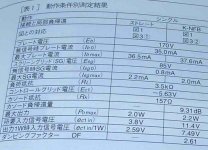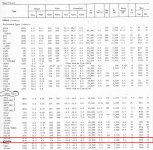First of all I wanted to replace the original tube with something still manufactured. Maybe one day the PCL86 will become scarse and then what? back to the drawing board again.
As of now: 18.8.2020 unfortunately the ECL86 is not manufactured and no other tube is that is a candidate for replacement.
The ECC85 is still manufactured, and the EL84 aswell.
I get you but how many do you really need? Buy a box of them and forget it?
I don't get it and feel something pulling my leg.
So if the supposed future scarcity of the PCL86 is a real issue, than what about the availability in the future of other common tube types in tube radio's, like ECH81, EF85, EF89, EABC80, etc.? I don't think it is a realistic scenario that the world will run out of PCL86's but not out of one or more of them.
PCL86's are still widely available, for low prices (lower than ECC85 and way lower than EL84). And TS said earlier in this thread that he even has some PCL86's already.
So if the supposed future scarcity of the PCL86 is a real issue, than what about the availability in the future of other common tube types in tube radio's, like ECH81, EF85, EF89, EABC80, etc.? I don't think it is a realistic scenario that the world will run out of PCL86's but not out of one or more of them.
PCL86's are still widely available, for low prices (lower than ECC85 and way lower than EL84). And TS said earlier in this thread that he even has some PCL86's already.
The ECC85, as suggested by the thread starter, can successfully be replaced by the ECC81/12AT7, which is still manufactured. Their data are close enough.
Anyway, the ECC81/85 triodes by far aren't alike the ECL86 triode, which is half of a ECC83/12AX7. And this tube is well on demand, hence manufactured, today! So I don't understand why even thinkering with ECC85 😕?
Best regards!
Anyway, the ECC81/85 triodes by far aren't alike the ECL86 triode, which is half of a ECC83/12AX7. And this tube is well on demand, hence manufactured, today! So I don't understand why even thinkering with ECC85 😕?
Best regards!
By who?
Im sorry I just realised that I misstiped "ECC85" when it should have been 83..
But it will be manufactured by JJ soon ish (yes the ECC85.)
According to r-type: "The 6AQ8 was the standard double triode for use in the front end stages of FM radio receivers. It was designed specifically for the purpose."
EH makes a 6AQ8. (6AQ8=ECC85)

EH makes a 6AQ8. (6AQ8=ECC85)

Alternative?
Hello diy-ers. Lots of ideas here. I would like to add two more options.
1. A suitable alternative for the ecl86, besides the already mentioned pcl86 would be the ecl85/ecl805. It is not designed for audio but for your purpose it would be fine. It can handle voltages up to 300v so no problem. Pentode plate dissipation is in the same league as the ecl86. A little rewiring and resistor tweaking required.
6F5P / ECL85 / 6VG8 tube → POWER / OUTPUT tubes → Tubes-Store.com
Security Check
2. Use a el84 or other simular pentode and make the triode gain stage with a mosfet, like LND150. Simpel and plenty of gain.
Security Check
Either option will be cheap. Russian tube 6f5p is the same as the ecl85. Even cheaper! Buy a few spares 🙂
Tubes-Store.com
Whatever you decide, good luck!
Hello diy-ers. Lots of ideas here. I would like to add two more options.
1. A suitable alternative for the ecl86, besides the already mentioned pcl86 would be the ecl85/ecl805. It is not designed for audio but for your purpose it would be fine. It can handle voltages up to 300v so no problem. Pentode plate dissipation is in the same league as the ecl86. A little rewiring and resistor tweaking required.
6F5P / ECL85 / 6VG8 tube → POWER / OUTPUT tubes → Tubes-Store.com
Security Check
2. Use a el84 or other simular pentode and make the triode gain stage with a mosfet, like LND150. Simpel and plenty of gain.
Security Check
Either option will be cheap. Russian tube 6f5p is the same as the ecl85. Even cheaper! Buy a few spares 🙂
Tubes-Store.com
Whatever you decide, good luck!
1. A suitable alternative for the ecl86, besides the already mentioned pcl86 would be the ecl85/ecl805. It is not designed for audio but for your purpose it would be fine. It can handle voltages up to 300v so no problem. Pentode plate dissipation is in the same league as the ecl86. A little rewiring and resistor tweaking required.
Philips did use the PCL85 for audio (as part of sepp otl output stages for 800 Ohm loudspeakers) in some of their TV's.
But the ECL85/ECL805 is not pin-compatible with the xCL86, so the adapter would get more complicated. You would also need an extra cathode resistor of some size to get the much higher Vg1 (I estimate about 20 Volt extra is needed). This extra voltage over the cathode resistor will lower Vak and Vg2k, which will reduce output power.
Because of the rule that for pentodes Rload = Vak/Ia, you will not have much room to run the ECL85/ECL805 with a different Ia as with the original ECL86.
The triode section of the ECL85/ECL805 (mu = 60) will give some less amplification than the triode section of the xCL86 (mu = 100).
Possible, yes. But imho not very atractive.
Yes, but what is your point?
I don't understand Japanese (or Chinese?) but I see: "(Eb) 170V" and "(Esg) 85V". That means the tube is running with a supply voltage of 170V and a screen grid voltage of 85V.
But in most radios with an ECL86, the ECL86 is being run with a supply and screen grid (!) voltage of 250V. A good look at the curves in the datasheets of the ECL85/ECL805 will learn that with Va = Vg2 = 250V you will need a negative grid voltage of about -26V to get the ECL85/ECL805 to only pass the anode current of about 36 mA which an xCL86 at these voltages would do.
That was and is my point. To correct for the differences between the xCL86 and ECL85/ECL805 is very unpractical. And even than it will be an inferior replacement.
My point is not that the ECL85/ECL805 is unusable for audio. I began post #110 with examples of them being used for audio.
I don't understand Japanese (or Chinese?) but I see: "(Eb) 170V" and "(Esg) 85V". That means the tube is running with a supply voltage of 170V and a screen grid voltage of 85V.
But in most radios with an ECL86, the ECL86 is being run with a supply and screen grid (!) voltage of 250V. A good look at the curves in the datasheets of the ECL85/ECL805 will learn that with Va = Vg2 = 250V you will need a negative grid voltage of about -26V to get the ECL85/ECL805 to only pass the anode current of about 36 mA which an xCL86 at these voltages would do.
That was and is my point. To correct for the differences between the xCL86 and ECL85/ECL805 is very unpractical. And even than it will be an inferior replacement.
My point is not that the ECL85/ECL805 is unusable for audio. I began post #110 with examples of them being used for audio.
Last edited:
The ECL85 is not unusable in audio amplifiers, but the features are so different from the ECL86 that without major modifications to the amplifier (which includes even the eventual replacement of the output transformer) it cannot easily be used instead.
Simple PCL805 push-pull amplifier
Simple PCL805 push-pull amplifier
Last edited:
I just tried it in a Hammond AO-44 amplifer. This one was used in later versions of the A-100 and M-100 organs as the reverberation amplifier and features a pair of ECL86/6GW8's. I quickly soldered a Delon doubler with IR 30S1 diodes, that aren't even Schottkys, and 2.2 mF 25V 'lytics. With it's original power tranny the heater voltage slowly climbed 'till 12.8 Vdc, which should be sufficient for these tubes. As both the plate and heater windings are CT'ed, this heater voltage also is perfectly balanced at +/- 6.4 Vdc w.r.t. GND.
Best regards!
I think your result of 12.8Vdc is only possible if the filament voltage in your Hammond AO-44 is higher than 6.3Vac. The doubling of the voltage is only reachable in theory. In real life you will have some losses, so with 6.3Vac, it is simply impossible to reach your 12.8Vdc.
Did you measure the input voltage? Was it something like 6.7Vac, as a result of the mains voltage nowadays being about 235V instead of the 220V from the old days?
Since most (all) radios with ECL86 were made for 220V, your proposed voltage doubler will do the trick, because you'll have about 6.7Vac to start with.
Attachments
Last edited:
Yes, but you need a DC input voltage for that, so you would need additional rectification and smoothing of the AC.
But if the voltage doubler Kay proposed delivers enough output voltage for the PCL86 (probably made possible because of the available input voltage of 6.7Vac), than it doesn't make sense to add a DC-DC boost converter.
But if the voltage doubler Kay proposed delivers enough output voltage for the PCL86 (probably made possible because of the available input voltage of 6.7Vac), than it doesn't make sense to add a DC-DC boost converter.
Attachments
- Home
- Amplifiers
- Tubes / Valves
- Replacing the ECL86/PCL86 with two tubes



